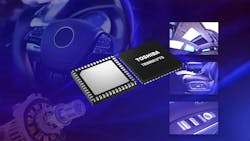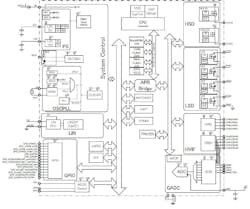Driver ICs Built for Automotive Brushed DC Motors
What you’ll learn:
- Why there’s a continuing role for brushed DC motors.
- The multitude of small-motor applications for autos.
- How motor drivers can enhance performance and connectivity.
It’s easy to assume that brushed DC motors have gone the way of dinosaurs in all but the lowest-end applications, replaced by more-sophisticated brushless DC motors (BLDCs) and stepper motors. However, that’s not the case at all.
The brushed DC motor has been around since the 1830s (yes, it’s been that long!), and billions of them have been used successfully. While there’s no denying that this motor arrangement experiences issues with brush wear and EMI, it’s served us well and had no DC competition until those electrically commutated (EC) motors became widely available and cost-effective.
Despite the extensive use of EC motors, brushed motors haven’t been relegated to just ultra-low-end applications such as cheap toys, as they can be driven directly from the power source (being able to operate directly from the power rail without a driver s is one of their virtues) (Fig. 1).
Brushed motors are still the best choice in many applications with respect to size, performance, cost-effectiveness, and other critical parameters, especially when used with a driver that can control and modulate the applied power. I became aware of their ongoing viability when I saw a detailed design article by a company that makes brushed and brushless motors. This article analyzed why a brushed motor was the best technical choice for a medical infusion pump, clearly not a throwaway application.1,2
The Venerable Brushed Motor
Brushed motors are widely used in vehicles across the span from ICE to HEV and pure EV cars. The fact that today’s vehicles have an amazing number of smaller motors is a clear example of “no one saw this coming.”
How so? For decades between the invention of the electric starter by Charles F. Kettering for the 1912 Cadillac (and quickly adopted by all other cars) through the 1950s, cars had only one electric motor: the starter. Features added in the 1950s and 1960s, such as power windows were non-electric (the first ones were hydraulically powered), and even the air conditioner was powered by a take-off belt on the engine.3
In contrast, today’s cars typically have at least 35 to 40 motors for their visible and less-visible functions, and many of them operate using brushed motors. By pairing them with a suitable smart driver rather than simply being connected directly to the car’s DC rail, these motors can be precisely controlled and monitored for problems while providing power-efficient operation.
A New Motor-Driver Solution
Addressing the complex motor driver needs of modern cars, Toshiba Electronic Devices & Storage Corp. introduced the TB9M001FTG, the second device in the company’s Smart Motor Control Driver (dubbed SmartMCD) series. This highly integrated device is specifically designed to deliver efficient and accurate control of brushed DC motors in automotive applications, including electric sunroofs, wipers, powered windows, and adjustable seats.
This IC isn’t just an electronically controlled power switch with some added frills. Instead, the TB9M001FTG integrates four low-side drivers that function as relay drivers, enabling forward and reverse control of two brushed DC motors when using single-pole double-throw (SPDT) relays.
In addition, the device features a built-in microcontroller (MCU) with an Arm Cortex-M0 core, 192 kB of program flash memory, an additional 16 kB of data flash memory, and a LIN ISO17987/SAEJ2602 transceiver + controller. The block diagram is highly detailed and can be intimidating (Fig. 2). Fortunately, the datasheet provides a detailed explanation of each major subblock in that complex figure.
The two high-side drivers support 5- and 12-V loads to external components, and a fully integrated power-management system generates all of the required voltage levels from the car battery. These functions are integrated into a compact VQFN48 package measuring just 7 × 7 mm, enabling engineers to achieve more compact system designs and reduce component count.
Among its long list of functions and features are:
- 32-bit compare timers
- 28-bit capture timer (8 inputs, 6 measurement)
- Watchdog timer
- Power-saving modes (CPU sleep, standby, wake up)
- 4 legacy PWM generators
- 14 general-purpose (GPIO) I/O ports
- 10-bit analog-to-digital converter with 13 analog inputs + internal temperature, VB, VCC monitoring
- 4 low-side drivers
- 2 high-side drivers
- 9 high-voltage inputs
- 2 LDOs
- Power-on reset
- 2 on-chip oscillators plus external oscillator
- Phase-locked loop (PLL)
- 2 full-duplex serial interfaces (one with LIN support)
- SPI interface
The driver operates from a single power supply between 6.0 and 18 V, and its specified for a junction temperature of −40 up to 150°C. The TB9M001FTG is AEC-Q100 (Grade 1) qualified and meets ASIL A requirements. It also includes robust safety features such as built-in error detections for overcurrent (low-side driver, high-side driver), overvoltage, undervoltage, and thermal-shutdown protection.
The comprehensive 38-page datasheet includes details about connections, static and dynamic performance, timing diagrams, logic levels, packaging and dimensions, and thermal insight. It also includes a full page with 16 “panes” showing the equivalent circuit for the many package pins. While many users may not care about these details, those who do will greatly appreciate seeing them here.
References
1. Medical Design Briefs, “Every Drop Counts: Designing Motors to Optimize Home and Ambulatory Infusion Pumps.”
2. Portescap, “Controlling Brushed DC Motors Using PWM – Optimal Frequency, Current Ripple and Life Considerations.”
3. CrankSHIFT, “History of the Starter Motor.”
About the Author

Bill Schweber
Contributing Editor
Bill Schweber is an electronics engineer who has written three textbooks on electronic communications systems, as well as hundreds of technical articles, opinion columns, and product features. In past roles, he worked as a technical website manager for multiple topic-specific sites for EE Times, as well as both the Executive Editor and Analog Editor at EDN.
At Analog Devices Inc., Bill was in marketing communications (public relations). As a result, he has been on both sides of the technical PR function, presenting company products, stories, and messages to the media and also as the recipient of these.
Prior to the MarCom role at Analog, Bill was associate editor of their respected technical journal and worked in their product marketing and applications engineering groups. Before those roles, he was at Instron Corp., doing hands-on analog- and power-circuit design and systems integration for materials-testing machine controls.
Bill has an MSEE (Univ. of Mass) and BSEE (Columbia Univ.), is a Registered Professional Engineer, and holds an Advanced Class amateur radio license. He has also planned, written, and presented online courses on a variety of engineering topics, including MOSFET basics, ADC selection, and driving LEDs.


